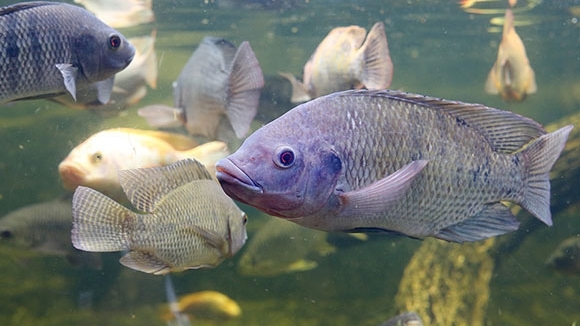Aquaculture Health

Aquaculture, the production of aquatic animals and plants under controlled conditions, is an ever-growing agribusiness in the United States and worldwide. The impact of disease on aquatic livestock, like all livestock sectors, includes production and market loss and increased costs. APHIS supports U.S. aquaculture industries by protecting aquatic livestock health, promoting U.S. farm-raised aquaculture products, and protecting natural resources.
APHIS works with U.S. aquaculture producers, allied businesses, associations, and partners to improve, establish, and maintain healthy aquatic livestock and promote sustainable production practices. We support risk-based approaches to demonstrate and protect aquatic livestock health and ensure farm-raised aquatic animals' safe and secure movement.
Report Signs of Animal Disease
Producers or owners who suspect an animal disease should contact their veterinarian to evaluate the animal(s). Find an accredited veterinarian.
Animal health professionals (veterinarians; diagnostic laboratories; public health, zoo, or wildlife personnel; and others) report diagnosed or suspected cases of nationally listed reportable animal diseases to APHIS Area Veterinarians in Charge.
Information on Reportable Diseases and Pathogens of Concern
Diseases and pathogens of concern to U.S. aquaculture are in the National List of Reportable Animal Diseases. This also includes a number of World Organisation for Animal Health -listed aquatic animal diseases.
If you suspect diseases or pathogens on these lists, report it.
APHIS works continually to identify potential risks and respond to requests for epidemiological information about diseases that could threaten commercial aquaculture industry sectors in the United States.
- Salmonid Pathogen Pathways Assessment and Hazard Identification (ID) Information
- Pathways Assessment for Live Salmonid Fish, Eggs, and Gametes Susceptible to Six World Organization for Animal Health Listed Pathogens (2.5 MB)
- Hazard ID - Epizootic hematopoietic necrosis virus (EHNV) (580.1 KB)
- Hazard ID - Gyrodactylus salaris (669.55 KB)
- Hazard ID - Infectious hematopoietic necrosis virus (IHNV) (681.4 KB)
- Hazard ID - Infectious Salmon Anemia Virus (ISAV) (654.54 KB)
- Hazard ID - Salmonid alphavirus (SAV) (716.44 KB)
- Hazard ID - Viral Haemorrhagic Septicemia Virus (VHSV) (724.74 KB)
- Megalocytivirus Pagrus-1
- Virulent Aeromonas hydrophila (vAh)
- Tilapia Lake Virus (TiLV)
- Assessment of the Risk of Introduction of TiLV by Live Tilapia Imported to Terminal Markets (270.88 KB)
- Rapid Risk Assessment for Tilapia Lake Virus (TiLV) (569.5 KB)
- Analysis of U.S. Imports/Exports of Live Tilapia and Eggs/Milt (318.38 KB)
- Emerging Risk to Animal Health Notice: TiLV (164.9 KB)
- Preliminary Risk Assessment for TiLV (221.12 KB)
- Decapod Iridescent Virus (DIV1) Rapid Risk Assessment (946.91 KB)
- Infection With Infectious Hypodermal and Hematopoietic Necrosis Virus (IHHNV)
- IHHNV: Rapid Risk Assessment (1.2 MB)
- Emerging Risk Notice: IHHNV (106.18 KB)
- Information Sheet: IHHNV (358.03 KB)
- Ostreid Herpevirus (OsHV)
- Frequently Asked Questions: Infection by OsHV-1 Microvariants
- Information Sheet: OsHV-1 (289.75 KB)
- Potential Introduction Pathways of OsHV-1 in the United States (746.37 KB)
- Optimizing surveillance for early disease detection: Expert guidance for Ostreid herpesvirus surveillance design and system sensitivity calculation (Gustafson et al. 2021)
Aquatic Animal Health Status Reviews
We conduct annual reviews to determine the health status of select aquatic animal pathogens of concern for the United States or regions within the United States.

